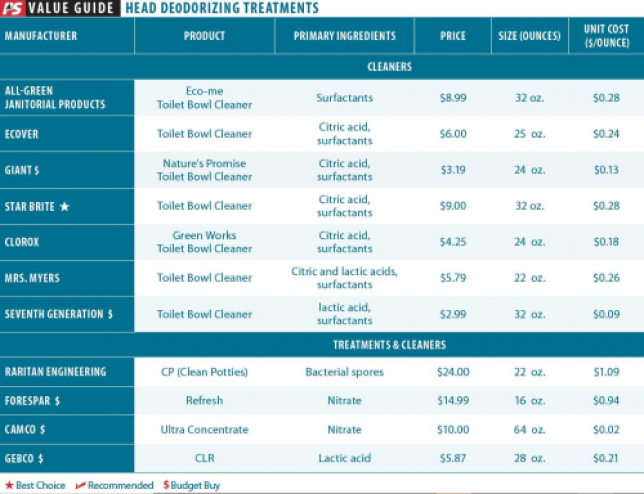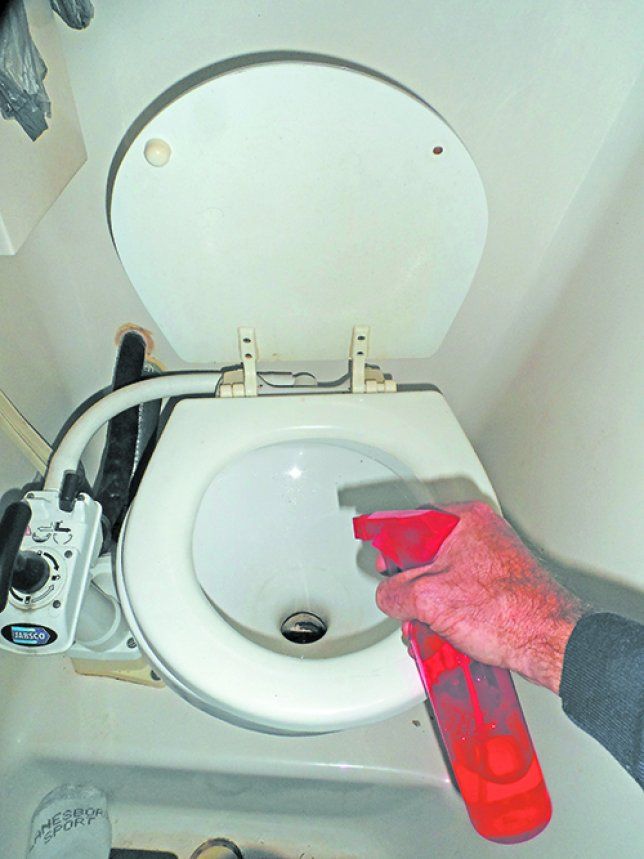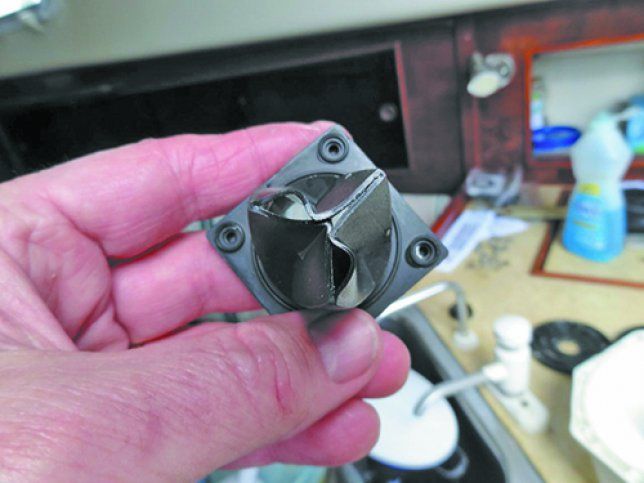It’s not sailing, but we’ve got to talk about it because it’s not fun when it goes wrong. The head. We’ve reported on the best hoses, joker valves, toilet paper, and holding tank treatments. Recently readers have asked about cleaners that are safe, and sure enough, over the years we’ve run into evidence that improper cleaning can do real harm.
We’re going to coach you to clean in moderation, because any cleaner that is harsh enough to meet the expectations of a homeowner looking for minimal work is also likely to damage your head and holding tank system. Any sanitizing agent strong enough to quickly kill what’s in the bowl will slowly kill the beneficial bacteria in the holding tank, leading to increased sludge and odors. Any cleaner packed with sufficient surfactants and degreasers to power though dried-on crud will also remove the grease and lubrication from the pump, and the leading cause of death of head pumps is insufficient lubrication. And more often than not, they use chemicals that are damaging to rubber parts in the head and sanitation hoses. So we’re going to ask you to take it easy on the cleaners and recommend a gentle approach.
But the lubrication problem can be treated by flushing with oil, you say. Nope. PS testing has shown that flushing vegetable oil increases grease-related sludge in hoses, tanks, and joker valves. This in turn accelerates the build-up of scale and makes it more difficult for acid cleaners, such as vinegar or CLR, to remove scale deposits. The oil also swells joker valves and distorts flappers, as do some of the other cleaner ingredients. By adding oil, you are acting at cross purposes to good head maintenance.
Note: The conclusions from this report are based on product tests as well as independent work by the tester (a wastewater expert) that measured the effects of the various chemical treatments and cleaner biocides described in this article.
The Bad Actors
We could go through the whole list of cleaners you shouldn’t use, but there will always be new formulas. Instead, let’s look at the ingredients that do the most harm. You’ll need to read the ingredients on the bottle and the MSDS. An MSDS is not a precise spec sheet, but fortunately, it must disclose the toxic, biocidal, and corrosive ingredients, so for our purposes, they’re a great start.
Bleach. Bleach is deadly to bacteria at just a few ppm. Even worse, chlorine reacts with ammonia from urine to make chloramine, which is more long-lasting than bleach. The argument by Clorox that bleach is OK for septic systems is as full of holes as is the notion that flushable wipes are, well, flushable. You might get away with it, but in both cases, hidden damage is nearly certain.
Quaternary Amines. Most of the bleach-free products contain substituted amines, which although less odorous, are nearly as toxic to bacteria. One of the most common, BAC (benzalkonium chloride), is known to inhibit biotreatment at just 5-20 ppm, making it nearly as toxic as bleach. Assuming the typical 1-2 percent ratio of active ingredients, just 0.1- to 0.4-ounce is needed to impact 20 gallons of blackwater! In fact, some of the antiseptic portable head treatments we tested (Controlling Porta Potty Odor, September 2018) were based on quaternary amines. Numerous sewer authorities have either banned or regulate the discharge of wastes treated with these chemicals. So they are bad. Also avoid amine oxide, laurydimethylamine oxide, and ethoxylated amines.
If that were not enough, the benzene makes BAC among the most damaging chemicals to joker valves. If used just a little on the strong side and allowed to soak, distortion and even blistering is possible.
Other Antiseptic Agents. Formaldahyde, dowicil, gluteraldehyde, and bronopol (aka 2-BROMO-2-NITROPROPANE-1,3-DIO) are all to be avoided. Bronopol is found in Thetford Blue and is deadly to bacteria. We recommended this for portable heads, but never for holding tank systems, which depend upon friendly bacteria.
Borax. We’ve been preaching the value of borax as an anti-mildew agent for years. Diesel biocides (Biobor JF) use boron compounds to kill bacteria and mold. In high concentrations, borax is effective as a herbicide. Unsurprisingly, it can also kill helpful bacteria in your holding tank.
White vinegar. The conventional wisdom is that white vinegar helps with scale. However, PS testing shows it works so slowly as to be ineffective, and that it is rough on rubber parts and metals in the process. Other acids remove lime faster with less collateral damage, so we’re crossing white vinegar off the list, classifying it instead as a potentially damaging myth.
Strong acids or caustics (Lysol, Kaboom, Lime-Away). Hydrochloric acid, sulfamic acid, sodium hydroxide and other strong acids or bases can shift the pH of the holding tank away from the optimum range. Either can be lethal in high concentration, but more likely it will just smell a little worse, as the byproducts of decay and degradation become more odiforous.

The Good Actors
Modern head treatments are based on nitrates, surfactants, and enzymes, in a variety of formulations. What they have in common is that they reduce odors in the holding tank without any side effects, and if used in the bowl, treat the bowl and hose against smells, and slowly, and naturally help clean the bowl. A number of companies that make holding tank treatments (Camco, Forespar, Pure Oceans, Raritan) also make head cleaning formulations and they seem to know what they’re doing.
Lactic Acid. Lime stains require acid. CLR (lactic acid) has equivalent cleaning action at a similar price if diluted 10:1 before use. PS testing and industry references tell us that it is less damaging to elastomers, hoses, and metals. It also removes lime 10 times faster with smaller applications, resulting in lower cost. Although there are other acid products that excel at specific tasks, CLR has become our favorite multi-use organic acid for boat use because of its combination of safety around materials and effectiveness.
Surfactants (soaps). They help with scrubbing and are generally biodegradable, but they also will strip the grease from the head pump unless used in extreme moderation. Less is better, and in general with soaps, once it is enough to wet the soil, more doesn’t really help much.
Products
This listing does no more than scratch the surface. There are plenty of harmful home products in the grocery store, and more eco-friendly and marine products than we have mentioned. We encourage you to read the MSDS to be certain.
Mass-Market Products to Avoid

Basically, if it claims to kill germs or you see an antiseptic ingredient, don’t use it.
Lysol Power Toilet Bowl Cleaner. Contains hydrochloric acid and ethoxylated amines. The acid doesn’t concern us too much, but the amines do. $2.40/48 oz.
Clorox Toilet Bowl Cleaner/Cling Bleach Gel. Bleach in the name tells you all you need to know. Bad for the head, murder for the bugs. $1.76/ 24 oz.
Arm & Hammer Kaboom Bowl Blaster. Performs like Lysol, acid, and amines. It will do more harm than good with holding tanks. $3.80/24 oz.
Marine and Green Cleaners

Just because it says eco is no guarantee its harmless to the marine environment. Read the MSDS. These passed our scrutiny. They all worked when given a little time for the weak acid to soak. Star brite seemed fastest.
Ecover. Citric acid and surfactants. $6 for 25 oz.
All-Green Janitorial Products Eco-Me. Citric acid and surfactants. $8.99 for 32 oz.
Clorox Green Works $12 for a 96 ounces (4 pack).
Seventh Generation Toilet Bowl Cleaner Lactic acid and surfactants. $2.99 for 32 oz.
Natures Promise (Giant) Toilet Bowl Cleaner. Citric acid and surfactants. $3.19 for 24 oz.
Mrs. Meyers Toilet Bowl Cleaner. Lactic acid, citric acid, and surfactants. $5.79 for 24 oz.
Raritan CP (Clean Potties). Bacterial spores. $24 for 22 oz.
Star brite Toilet Bowl Cleaner. Citric acid and surfactants. $9 for 32 oz.
Lysol Disinfecting Toilet Wand (with refills). Scrubbing wands soaked with glycolic acid and surfactants. Single use and then dispose (do NOT flush). This approach adds another eco-problem to the mix: more single-use plastic. No thanks. $6.59 for 10.
Other Spray Options
While not fundamentally cleaners, we’ve found a regular spray of these products into the bowl, diluted about 10:1, keeps things odor free and clean. An occasional scrub may be needed.
Forespar Refresh Nitrate, enzymes, and surfactants. $14.99 for 16 oz.
Camco Ultra Concentrate Nitrate and surfactants. $10 for 64 oz.
Conclusions
The majority of grocery store toilet bowl cleaners contain bactericides that inhibit bacterial activity in the holding tank and contribute to bad smells. These same chemicals attack the head pump and hose materials, shortening their lives and increasing permeation. There are a handful of eco-friendly and septic-friendly products that work, but you’ll need to read the MSDS sheets and check them against out list of damaging ingredients to be certain.
We strongly urge cleaning in moderation. Anything that contains enough surfactant to make a real difference will logically also strip grease from the head pump. A better strategy is to spray the bowl regularly with a dilution of either one of the suggested head treatments or Raritan CP. Apply elbow grease when needed, and a little CLR for stubborn lime deposits.
In this way the cleaning action is concentrated only where it is needed. When you do need a cleaner, avoid bleach, quaternary amines, and solvents, and use one of our recommended products in moderation. A prolonged soak in a mild acid (CLR, Sew Clean, or other PS tested descaler) to remove calcium deposits from the joker valve and hose is okay, but otherwise avoid long soaks.









































We typically follow mfr’s recommendation and consult as we need to via e-mail or phone with the “head mistress”, Peggy Hall.
I started using Roebic septic treatment products in my holding tanks for the last year and can’t believe how well it has performed.
The first thing I noticed was more usable space in the tank. The enzymes break down the solids which mix with the liquids instead of separating into 2 layers.
The second thing was no more odors coming from the heads.
And lastly pumping out was a noticeable difference with everything more dissolved coming out of the tank.
Would be interesting to see a more conclusive test done with these products as they seem to meet the criteria of using bacteria for a healthy holding tank.
Unchloric Acid has been recommended to inhibit/prevent salt buildup and clogging of hoses, diverter valve, thru-hulls..What, exactly is it, and do you concur?
“extreme moderation” – what the heck is that supposed to mean?
Thanks for sharing your experience, Evertt. I’ll pass this on to Drew Frye for comment. Many of the products we test share similar formulas (sometimes the same) to ones we have not — this might be one. If it is different, we’ll add it to the next round.
Peggy Hall is a great source of information, and she has been very supportive of our research in this area.
I recently started using Noflex Digestor with excellent results.
I buy CITRIC acid (food grade) by the kilo and use 100 grams per liter to get rid of scale and the such.
So far, my joker valve as not been damaged.
Been doing so for years.
As for killing bacteria in water tanks, 1 liter of 50% strong H2O2 per 1000 liters does the trick for me.
Been doing so for years.
What about “Unchloric Acid”? I’ve seen reports that this is very effective for cleaning sanitation lines and holding tanks.